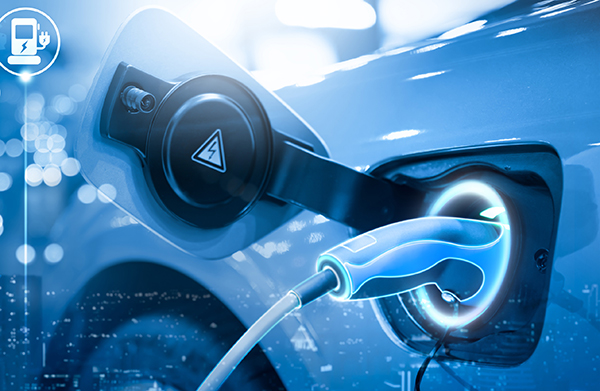Volume 26 | Issue 2
Click here to read the complete illustrated article or continue below to read the text article.
During the dynamic journey of the past decade, the electric vehicle battery landscape has been a hotbed of innovation. It has seen extraordinary strides in materials, manufacturing methods, and sustainability practices. This evolution has not only reshaped the EV landscape but has also unveiled a world of intriguing challenges and exciting prospects for domestic manufacturers.

Over the past decade, the EV battery industry has witnessed a tremendous shift in its landscape, driven by a relentless pursuit of excellence. One key area of development has been the enhancement of battery materials and manufacturing processes, resulting in higher energy density, lower costs, and increased production volumes.
Manufacturers are increasingly adopting advanced manufacturing techniques, incorporating innovations such as adhesives and adhesive dispense technology. Adhesives, once avoided due to quality control challenges and environmental considerations, now play a pivotal role in the creation of durable, high-performance battery packs. Furthermore, traditional welding techniques are being supplanted by more efficient processes like ultrasonic wire bonding and laser welding. These methods not only enhance productivity but also deliver superior quality control.
While the future of domestic EV battery production appears promising, several challenges need to be addressed. One of the primary hurdles is the shortage of a well-trained and experienced American manufacturing workforce. Battery manufacturing requires a unique set of skills, from process control to quality assurance and safety management. There is still a limited pool of experts with holistic knowledge in battery technology or production, which can hinder the scaling-up process.
Another challenge arises from workplace safety practices that were not designed to accommodate the specific needs of battery manufacturing. The existing safety standards and regulations can be difficult to apply without that hampering productivity and efficiency. To facilitate progress, the industry must adapt these standards and deploy practical guidelines that promote safety through a knowledgeable workforce, rather than imposing blanket restrictions on working with live batteries. This could involve measures such as verifying the proper functioning of electrical insulation, conducting voltage checks before handling items of uncertain integrity, and responding effectively to battery-related thermal events.
The integration of automation offers clear benefits, but it should not solely be driven by a response to regulatory constraints. Rather, it should be seen as a complementary solution. One key advantage of automation is its ability to sidestep specific safety regulations that apply to human workers. Manufacturers often favor robots for certain tasks due to their convenience and reduced risk. However, an excessive reliance on automation can hinder the development of manufacturing processes and result in fewer job opportunities, ultimately limiting the industry’s adaptability.
To address these challenges, forward-thinking companies are taking the initiative to provide internal training programs that adhere to safety regulations while also emphasizing best practices and hazard mitigation, as they understand that having a well-prepared workforce is a critical aspect of overcoming these hurdles.
Government policies and incentives play a pivotal role in promoting domestic EV battery production, and recent developments are crucial in this rapidly evolving landscape. The United States Department of Energy (DOE) has committed $15.5 billion to support the transition to electric vehicles, aligning with President Joe Biden’s Investing in America agenda.
The substantial budget will primarily aid automakers and suppliers in retooling their facilities to produce electric, hybrid, and hydrogen fuel cell vehicles, with $12 billion earmarked for automotive manufacturing conversion projects, supported by a combination of $2 billion in grants and $10 billion in loans. An additional $3.5 billion will be directed toward expanding domestic battery manufacturing for EVs and grid applications, including battery materials and components, traditionally imported from other countries.
The government’s incentives, coupled with the dynamic landscape of battery manufacturing, exemplify the pivotal role that domestic EV battery production plays in the future of the industry. These investments empower the United States to fortify its position as a key player in the global EV market, ensuring not only economic prosperity but also technological leadership in the transition to electric vehicles.
Domestic production of EV batteries offers significant economic and environmental advantages. The weight and bulk of batteries make transportation costs a substantial factor in the overall cost of EV production. By colocating various stages of battery production close to the end customer, manufacturers can reduce transportation costs, thereby decreasing their carbon footprint.
Furthermore, economic incentives, such as tax benefits for domestic production, are encouraging manufacturers to reconsider their strategies and focus on building a robust domestic supply chain. Policy shifts, such as those seen under the Biden administration, provide tangible benefits, making it more attractive for companies to manufacture batteries locally.
In addition to cost advantages, proximity to the manufacturing site offers an unmatched advantage in terms of response time. Battery technology is rapidly evolving, and having engineering teams closely connected to the production facility enables faster problem-solving and design iterations, ultimately leading to better products.
The evolution of domestic EV battery construction has been characterized by significant advancements in materials, manufacturing processes, and environmental sustainability. However, challenges persist, such as the need for a well-trained workforce and the adaptation of regulations to suit the evolving industry.
The economic and environmental advantages of domestic battery production are undeniable, as they reduce transportation costs and lead to faster development cycles. Government policies and incentives further boost the prospects of domestic battery manufacturing, facilitating the industry’s growth and development. As domestic manufacturers continue to push the boundaries of EV battery technology, they play a critical role in shaping the future of transportation and environmental sustainability.

About the Author
Rob Sweney is VP Engineering, Battery Systems at Lithos Energy, where he oversees mechanical engineering and validation. Prior to Lithos, Rob’s 15 years in EV powertrain development include leading major programs at Volkswagen / Audi, Lucid Motors, Alta Motors, and H-D LiveWire. Rob has a B.S. Engineering from Harvey Mudd College.
In this episode, I sat down with Beejan Giga, Director | Partner and Caleb Emerson, Senior Results Manager at Carpedia International. We discussed the insights behind their recent Industry Today article, “Thinking Three Moves Ahead” and together we explored how manufacturers can plan more strategically, align with their suppliers, and build the operational discipline needed to support intentional, sustainable growth. It was a conversation packed with practical perspectives on navigating a fast-changing industry landscape.